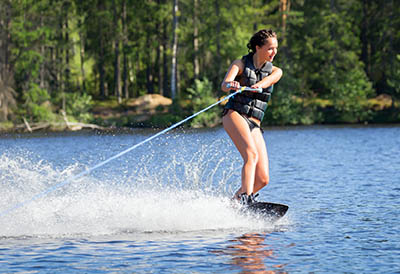Lean, Strong & Stable: Train like a Water Sport Athlete
July 12, 2017
If you’ve ever watched the Olympic Games, you might have noticed the endurance, flow and incredible muscular definition of swimmers, rowers, divers and other water sports elite.
Not to mention the water skiers and the surfers you see on vacation, so balanced and strong... Good news, you can build your skills and your physique with training fit for a summer athlete.
Whether you’re headed out to the lake for some boating fun, or are simply trying to whittle your waistline for a new swimsuit, you can add some of these exercises to help build your core, sculpt your shoulders and impress your friends on the shore.
- Stability. The nature of moving on the water dictates that there will be a certain amount of instability to contend with, and always more than land sports. If you’re seated with a solid surface under you, such as a canoe or kayak, stability becomes more about supporting your spine with strong abdominals and back muscles than about the equilibrium required to stay standing on the water (see equilibrium below).
One look at a rowing athlete’s midsection should give you a clue to the core strength required. So, here’s an obvious answer if you’re looking to develop in this way: get on that rowing machine! Other additions to your routine could include V-sits, Pilates, and Bosu Ball work. - Equilibrium. Standing water sports like water skiing or stand-up paddle-boarding require a slightly different take on stability—there’s the addition of the lower body, and also the fight against gravity and the power of the water’s momentum. Strength is required to support the lower body joints, making squats a valuable exercise, even better if you can do them with a balance board.
Another functional movement to train around is getting up from a kneeling position to standing. Plyometric (jumping exercises) are a good way to build this explosive power and balance. Also consider adding some stimuli that you’ll need to react to (like a big wave). A partner can help you train, tossing a medicine ball your way as you pop up from kneeling to standing, one leg at a time. Toss it back and get back down on the floor to start again. - Endurance. You’ll need to build muscular endurance as well as general stamina in your water sport training, but maybe you don’t have access to the water to do laps every day. There is plenty you can do in the gym to support your endurance work, beginning with one of the simplest recommendations: run. All cardio work supports water sports training in some way, but the running (aim for at least 20 minutes at 75% of your max heart rate) is a great choice to build stamina for the water.
Other efforts include cycling (extra lower body work there), dancing (a group fitness class like Zumba is a total body workout with a cardio aspect), or an elliptical workout (to get your upper body involved). All this training helps support longer efforts like full-day canoe trips, too. - Breathing. Breathing patterns can be a real weak link for many folks trying to train like an aquatic athlete. Breathing deeply and expanding that lung capacity will not only help you with stamina, but also transports oxygen throughout your body during exercise and recovery. A yoga practice or Pilates class can help a lot with breath, and you can add extra focus into your strength training routines as well. Something as simple as deep, full breathing during the V-sit we recommended for stability work, will be a smart addition to your workouts.
- Flexibility. Adequate range of motion matters in every athletic endeavor both to enhance your performance and help you avoid injuries while you’re at play—it’s no different in the water. From the flexibility needed in ankles for surfers to the hip flexors for seated paddlers, to the shoulders for swimmers, staying loose is a good idea if you’re training like a water sports athlete. You might head to yoga or Pilates class to help with this, and also, consider trying out accessories like a stability ball plus elastic tubing and bands, which can help you work on strength, balance and flexibility all at the same time.